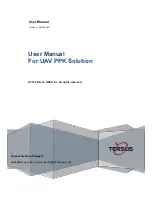
7. M
AINTENANCE
H
I
R
OLLER
- B
ELT
C
ONVEYORS
7.3. I
DLER
R
EPLACEMENT
- H
I
R
OLLER
M
ODELS
H
I
R
OLLER
, M
INI
R
OLLER
, L
O
R
OLLER
& H
I
L
IFE
98
P115506 R3
• The bearings and stub shafts should be replaced as an assembly when-
ever replacing the idler.
• If the existing bearings and stub shafts are to be reinstalled, make sure
that the stub shafts have the burrs and cuts removed with emory cloth.
• The inside of the idler center tube should be coated with an anti-seize type
product. This will allow for easier replacement in the future.
19. Align the bearings with the marks previously made during disassembly.
20. Tighten the bearing bolts on both sides - this MUST be done first.
21. Remove the self-drilling and -tapping screws installed to hold the nut
retainers.
22. Align the idler in the center of the trunking.
23. Tighten the set bolts securely.
24. Spin the idler to make sure it is centered and secure.
25. Retighten the set bolts.
26. Tighten the jam nuts on the set bolts.
27. Spin the idler to make sure it is centered and secure
28. Lubricate the bearings if they have not been filled with grease.
• It is very important to not over-grease these small bearings. It only
requires a small amount of grease to fill this type of bearing.
• Check the bearing manual for the proper grease for a specific application.
29. Inspect and remove all tools, parts, and components from inside and out of
the conveyor.
30. Complete a final inspection of the idlers and the conveyor in general.
31. Tension the belt properly using the “Belt Tension Procedure” on page 48. Set
the tension according to the specifications for this specific conveyor.
32. Install the covers making sure they are secured properly.
33. Test operate the conveyor without a load to make sure that the idlers are
operating properly.
34. Test operate the conveyor with a load to make sure that the idlers are
operating properly.
















































